The beauty of an air plant is that you can keep it just about anywhere. Rather than use its roots to absorb nutrients like a traditional plant, an air plant only uses its roots to climb. Air plants get all the nutrition they need from the surrounding air, so no need for soil.
They’re easy to care for, rewarding to grow, and there are more than 500 different types of air plants to choose from!
Here, we’ve selected 22 amazing air plants to get you started.
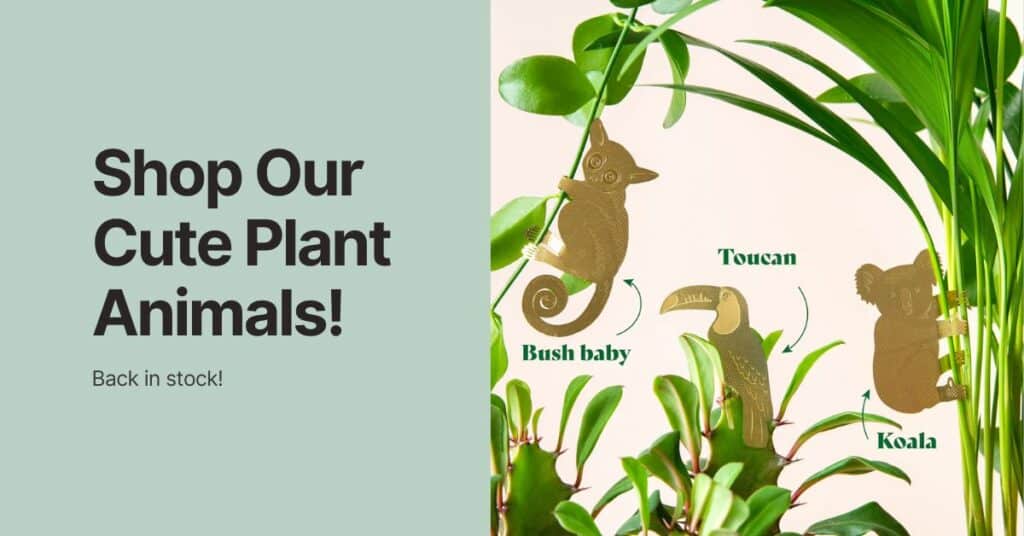
Air Plants Explained
But first, a few air plant basics. Air plants belong to the Tillandsia genus and the Bromeliad family, which is known for its colorful tropical plants.
Air plants grow in several natural environments across Central and Southern America and the southern regions of North America. Different types of air plants like different environments; you’ll typically find air plants in jungles, but others grow in other environments like mountainous regions, like the Tillandsia xerographica, or in deserts, see Tillandsia exserta.
Knowing your air plant’s native environment is important because it informs what sort of care you need to provide. There are three primary types of air plants: xeric, mesic, and hydric. These categories are based on the plant’s natural environment, though note that house plants tend to only be xeric or mesic.
Xeric plants, like the ionantha varieties, tend to be silvery-green and enjoy dryer conditions, while mesic air plants enjoy humid conditions, a moderate amount of water, and filtered light. These also tend to be waxier and have fewer trichomes, which is the name for the little fine hairs you’ll find on most xeric air plants.
Nearly all types of air plants will bloom once at the peak of their life cycle. Sadly, the bright, neon flowers are almost always an air plant’s last hurrah. After they bloom, most air plants will begin to die. Luckily, they’ll send out 2-8 “pups”, or offshoots, that will eventually grow into new, full-sized adult plants. Just don’t remove them too early! Pups need to be between a ⅓ and ½ their parent plant’s size before they can survive on their own. Or, you can leave them attached for a larger clump of air plants.
How to Care for an Air Plant
Air plants are unique in many ways but ultimately have similar needs as traditional plants. They may not need soil, but they still need water, sun, and proper airflow.
Air plants love light but don’t keep them on your South or West facing window sills because most do best in indirect light. A few feet away from a window or any other spot that receives good, filtered light is ideal. Air plants can survive a range of temperatures but prefer to be kept between 55 to 90°F.
When it comes to watering an air plant, you have two options: soaking or misting. The best way to water your air plant is to soak it every few weeks. Misting can work but may not be enough if you live in a dryer climate.
When soaking an air plant, fill your sink or a bowl with water and let your plants soak for about 5-10 minutes. If your plant is more bulbous, we recommend cutting the soak to less than a minute. Air plants are prone to rot if left wet, and certain varieties are especially susceptible.
The most important step in air plant care is to let them dry out after soaking. Returning a moist air plant to its terrarium or bowl is one of the most common ways that people kill their plants. Luckily, it is easy to avoid. Simply place air plants face down on a towel after soaking for at least 2 hours. If they’re still wet to the touch, they may need a little more time.
22 Awesome Types of Air Plants
Here are a few of our favorite air plant varieties and how to keep them:
Tillandsia Ionantha
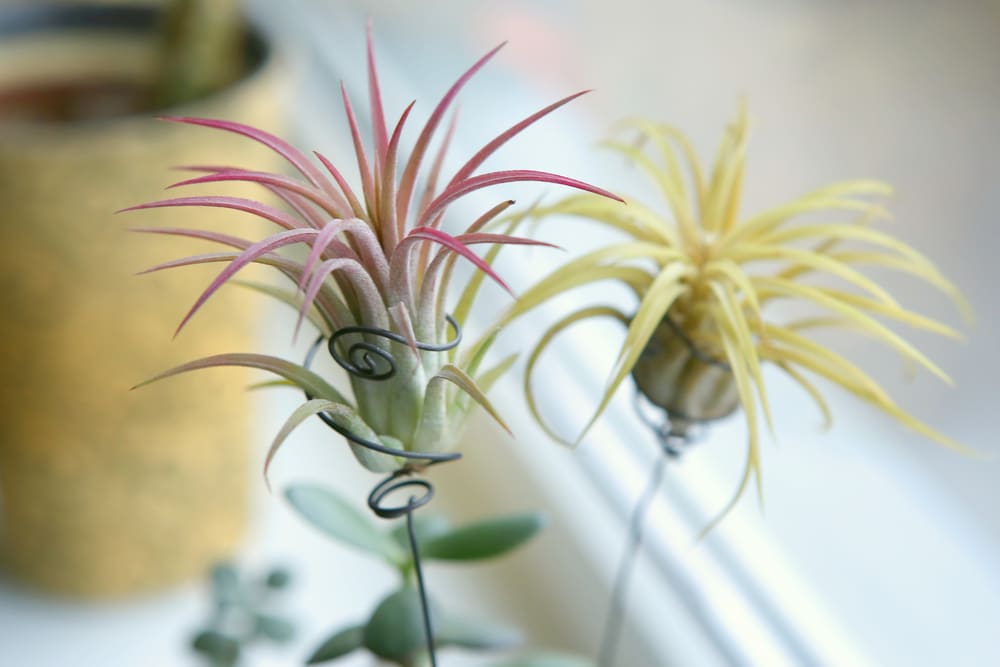
The Tillandsia ionantha, or sky plant, is one of the most popular air plants available. There are tons of ionantha cultivars, some of which you’ll find later on in this list!
The ionantha begins its life cycle with silver-green leaves that turn deeper green as the plant matures. The plant is known for its vibrant colors, but those will only begin to show at the onset of its bloom cycle. First, the leaves will turn red and pink, and then the plant will shoot out its characteristic yellow flower.
The ionantha grows naturally in tropical climates and is native to parts of South America and Mexico. Air plants are already low maintenance, but the ionantha is especially hardy. It enjoys bright, indirect light, and weekly or bi-weekly soaking.
Tillandsia Caput-Medusae
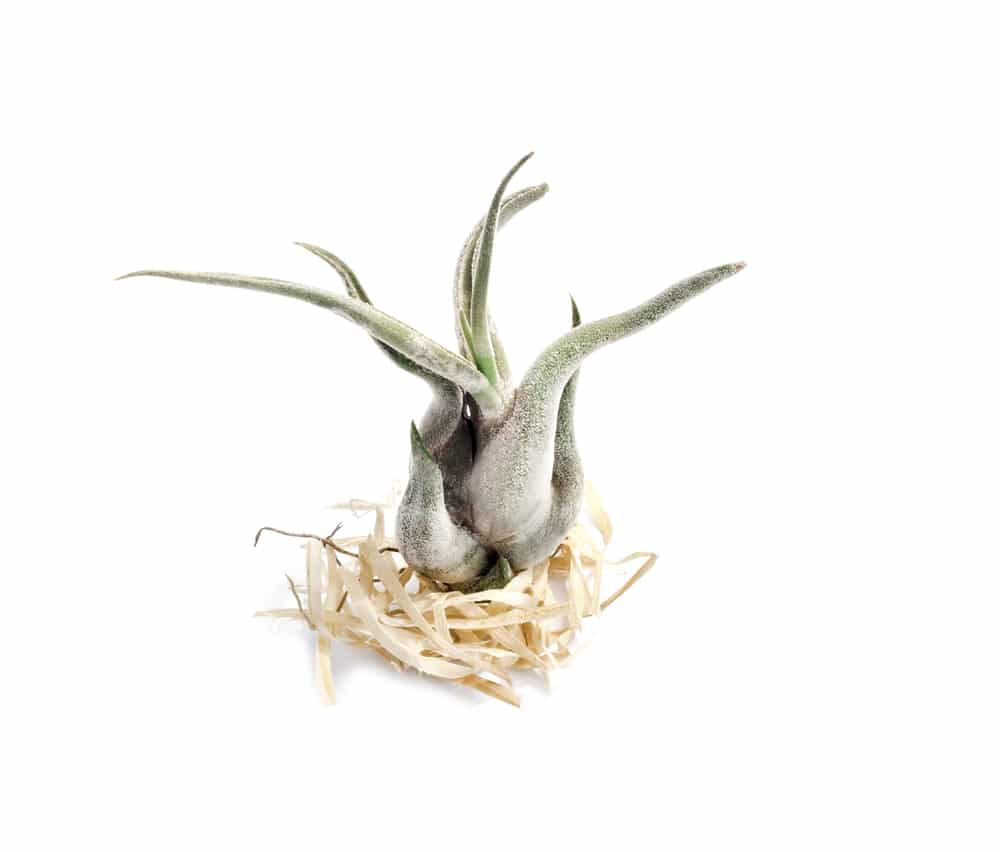
The unruly Tillandsia caput-medusae is commonly referred to as the head of Medusa. Tillandsia caput-medusae produce red or blue flowers and have wavy leaves that resemble medusa’s snake tendrils. Their foliage is fuzzy and silver-green with a purple hue that originates at the base.
The Tillandsia caput-medusae grows on tree branches in Central America and Mexico. As a xeric air plant, it does better in dry conditions and can tolerate more sun and less water than its mesic counterparts.
Tillandsia Xerographica
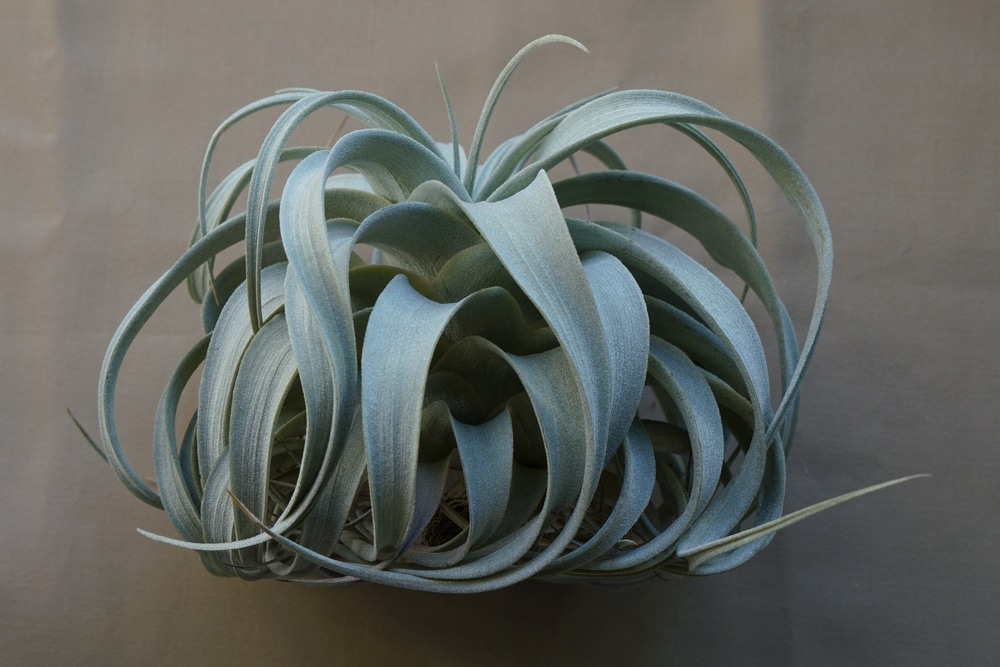
Tillandsia xerographica, affectionately referred to as xeros, originates from Mexico, El Salvador, and Guatemala. You can find it high up in the canopies of the subtropical forests in these regions.
Tillandsia xerographica’s leaves curl out, and under, giving it a distinct spherical shape. Eventually, it will produce a spike that will turn into a bright red or yellow flower. But don’t hold your breath waiting for that flower! This plant is incredibly slow-growing. Tillandsia xerographica is another drought-tolerant air plant.
Tillandsia Ionantha Maxima
Native to the Oaxaca region of Mexico, the Tillandsia maxima is known for its spectacular blooms. Just before it blooms, the plant’s deep green leaves will turn coral and it will produce a deep purple flower. It is also one of a few varieties that can produce multiple flowers simultaneously.
Like many other Mexico natives, the Tillandsia maxima is heat tolerant and enjoys a healthy amount of sun. It grows to around 5 inches tall, which is big for an ionantha air plant. In fact, it’s one of the largest types within the variety!
Tillandsia Cyanea
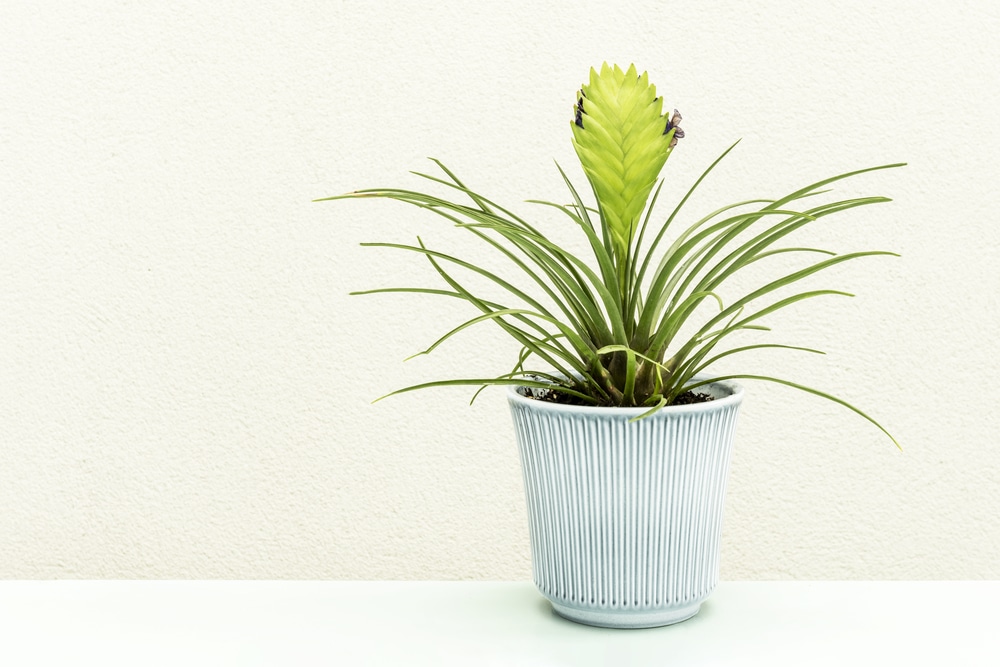
Tillandsia cyanea, or pink quill, is beloved for its showy pink, quill-like foliage and violet flowers. The pink quill is unique in that it can grow as an air plant and in soil. If planted in soil, it needs a loose and coarse mix and very light water. You may be better off just misting the leaves thoroughly as it is still an epiphytic plant. This means it still absorbs nutrients through its foliage rather than its roots. The pink quill is native to the rainforests of Ecuador.
Tillandsia Aeranthos Bergeri
Tillandsia bergeri have long spiky bracts that are gray-green and narrow. They can reach 9 inches in height, which makes them one of the taller plants on this list. When it comes time to bloom the Tillandsia bergeri will produce tiny pink and purple flowers with white centers and delicate, twisted petals. It grows quickly, and flowers for a few weeks in the summer.
Tillandsia bergeri is native to the mountainous regions of Argentina where it grows on rocks and tree branches. It is easy to care for and fast-growing.
Tillandsia Bulbosa
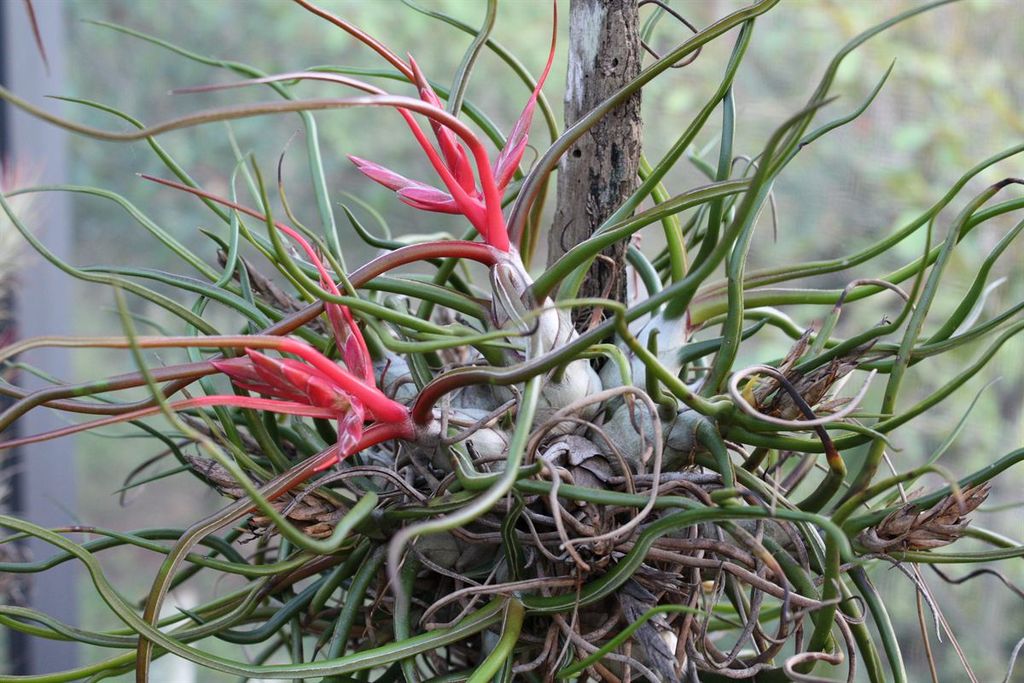
The Tillandsia bulbosa is as bulbous looking as the name implies. The leaves of this unique air plant grow wavy and disorganized around the central bulb. The leaves are dark green for the majority of the Tillandsia bulbosa’s life but will turn a lovely purple when it is ready to bloom. Its flowers are also purple.
The Tillandsia bulbosa is native to Mexico, Central, and South America. It has more relaxed watering needs than other air plants and is a good beginner option. All your Tillandsia bulbosa really needs is a few good mistings a week and indirect light.
Tillandsia Capitata
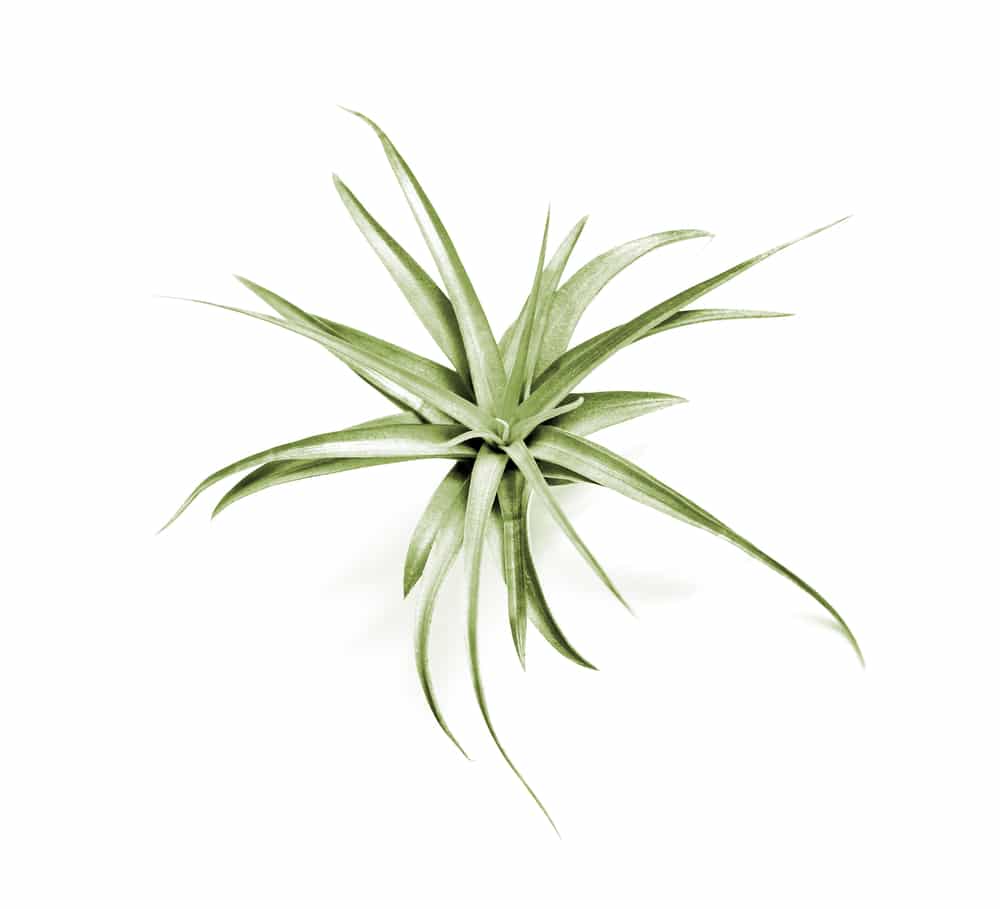
The Tillandsia capitata, or peach plant, is aptly named for its velvety- peach-toned leaves. It is native to Mexico, Cuba, Honduras, and the Dominican Republic, where it commonly grows among rocks and sometimes in trees. The leaves of a Tillandsia capitata grow in a rosette shape and will reveal a lovely, twisting purple flower when it blooms. As is common with drought-resistant plants, the Tillandsia capitata’s leaves have many hair-like trichomes which contribute to its velvety appearance.
The Tillandsia capitata can tolerate either filtered or full sun and thrives in humidity.
Tillandsia Houston “Cotton Candy”
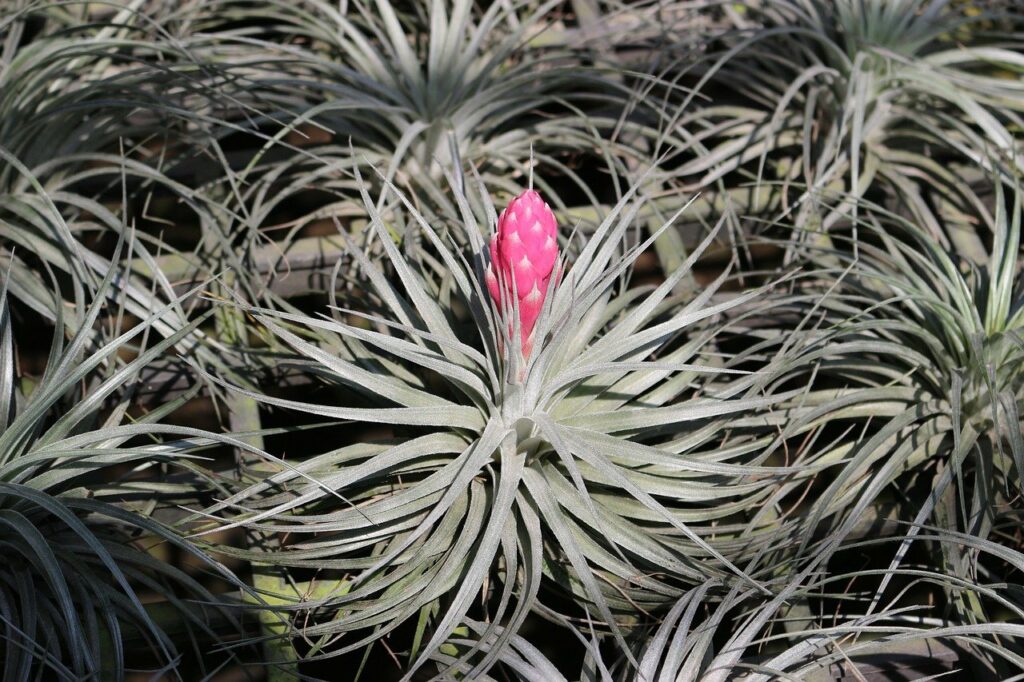
The Tillandsia cotton candy is a hybrid between a Tillandsia stricta and a Tillandsia recurvifolia. Its silvery-soft leaves grow in a rosette shape and take on a cotton candy pink hue before bloom. The cotton candy is known for its beautiful pink flower and soft structure compared with the Tillandsia Houston.
The Tillandsia cotton candy grows quickly and will produce a clump of offsets relatively quickly. It prefers plenty of bright indirect light and either frequent misting (2-3 times per week) or infrequent soaking (2-3 times a month).
Tillandsia Fuchsii v. Gracillis
Formerly labeled Tillandsia argentea, the Tillandsia fuschii v gracillis has a ball-like shape surrounded by an army of thin, spikey leaves. These sage-colored leaves are soft and fuzzy and come to resemble a perfect sphere over time. The unruly mass of bracts will eventually give way to a single spike that blooms into a pink and red flower.
The Tillandsia fuchsii v gracilis is the Guatemalan form of the fuchsii species. This delicate plant needs a healthy amount of water, so we recommend soaking it rather than relying solely on misting.
Tillandsia Funckiana
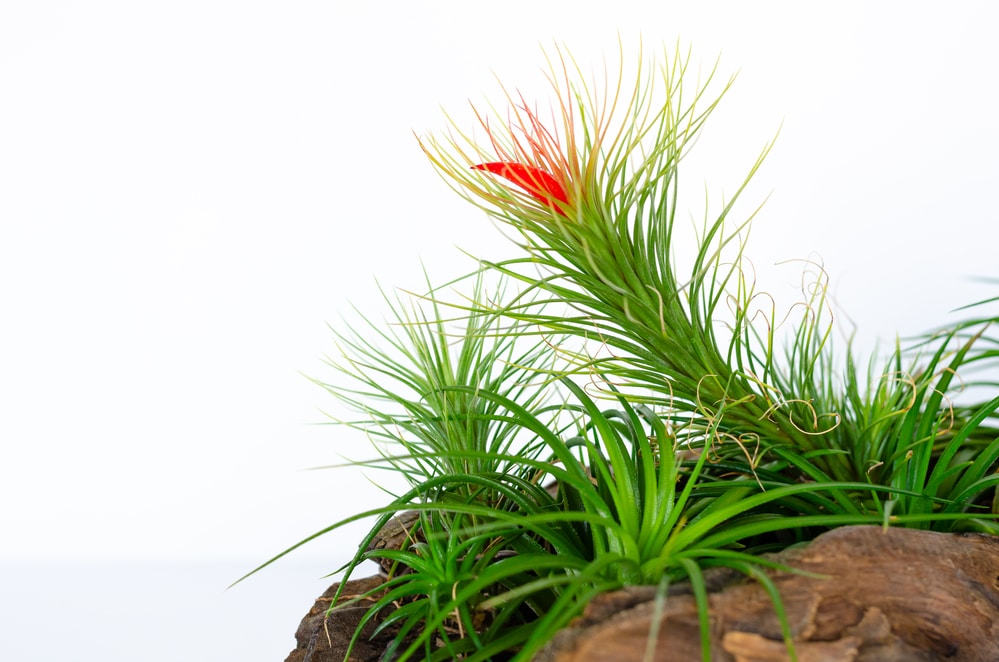
The Tillandsia funckiana grows up instead of out. The long twisting plant has quill-like leaves that spike out to resemble a pine tree. Its soft green quills will turn a muted yellow when it comes time to flower. It produces a single tubular orange or red flower, which is rare for air plants.
The Tillandsia funckiana can grow straight out or in a curved shape, depending on its environment. In nature, you’ll find it twisting through the harsh terrain of the Andes and Venezuelan cliff faces. The Tillandsia funckiana produces many offsets that clump easily, making it a popular decorative choice. It requires bright conditions and moderate water.
Tillandsia Gardneri
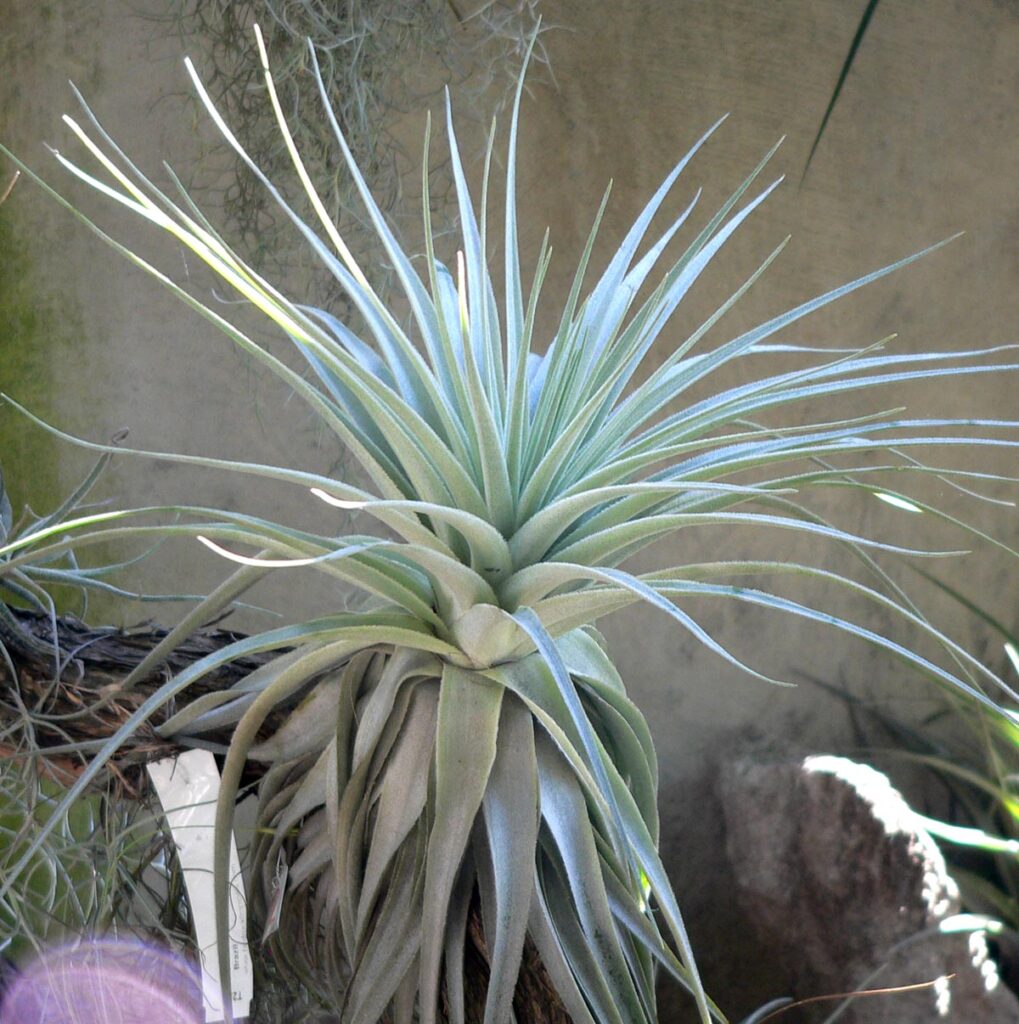
The Tillandsia Gardneri is native to parts of Latin America and Trinidad and Tobago. Their cascading silver leaves are soft and feather-like, and will become pink-hued when it comes time to bloom. While the Tillandsia gardneri is not endangered, it is slow-growing and highly desired by collectors, which has led to its overcollection in the past. Luckily, sustainable growth is made easy by the fact that the plant is self-pollinating. It may only produce one pup at a time, but it makes up for it by putting out seed pots that are choke-full of seeds.
The Tillandsia gardneri thrives in warmth and humidity but does not like direct sunlight. Its pink flowers tend to only come out during the summer months.
Tillandsia Stricta
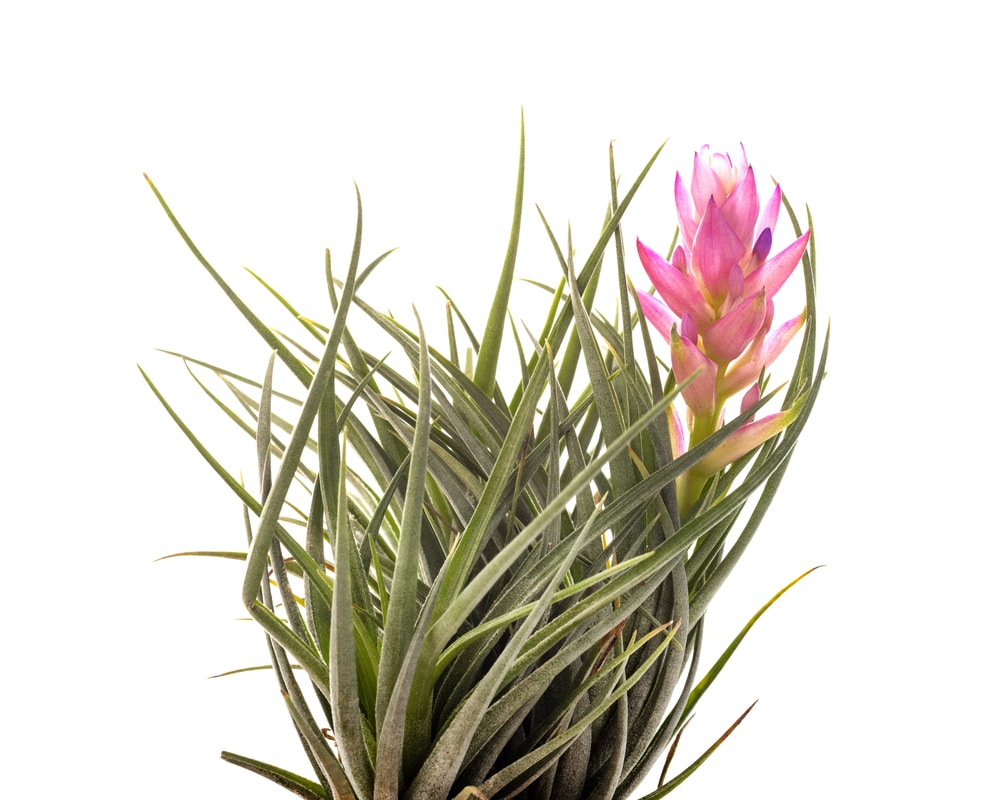
Earlier on this list, we mentioned the cotton candy plant which is a hybrid of the Tillandsia stricta and the Tillandsia recurvifolia. The Tillandsia stricta is an incredibly popular plant that is native to several environments. You’ll find it in sand dunes and treetops across the Caribbean and Latin America. As a result, the Tillandsia stricta can vary quite a bit in appearance and hardiness. Some types have softer, lighter leaves, while others are harder to the touch. Some are almost pink, like the ‘cotton candy,’ while others are close to black, like the ‘stricta midnight.’
Stricta flowers only last one day! However, the colorful leaves that develop before the bloom last about three months total. The stricta thrives in bright filtered light and produces plenty of pups that clump easily.
Tillandsia Chiapensis
Tillandsia chiapensis is native Chiapas, Mexico. It is a slow-growing plant with thick, velvet foliage that grows in attractive twists. While the Tillandsia chiapensis only grows to 5 inches across, it produces a large flower that can get to twice its size. The bracts are silver, and the long tubular flower is pink and red. The bloom spike can last up to 12 months, making it one of the longest blooming air plants out there!
The Tillandsia chiapensis thrives in a variety of conditions but prefers either full or moderate sun. It’s rare but would make a striking addition to any air plant collection if you can get your hands on it.
Tillandsia Ionantha ‘Fuego’
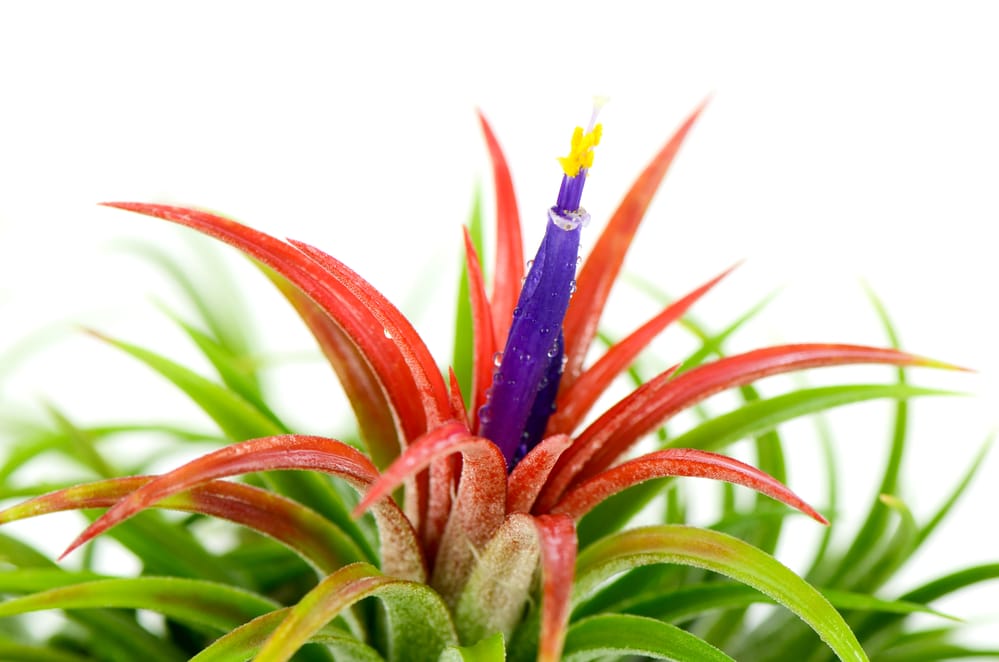
The Tillandsia ionantha ‘fuego’ gets its name from its distinct red color. This variety of ionantha has waxy green leaves that blush a vibrant red. While air plants tend to be small, the ‘fuego’ is on the smaller side of small, maxing out at just over an inch tall. It supplements its small stature with bright colors; the flowers bloom purple, and the red color lasts beyond just the bloom period.
The ‘fuego’ is native to Mexico and parts of Central America, where it blankets the forest floors. It likes warmth and humidity and can tolerate bright sunlight. It is a low-maintenance air plant that grows quickly and produces many offshoots.
Tillandsia Ionantha ‘Druid’
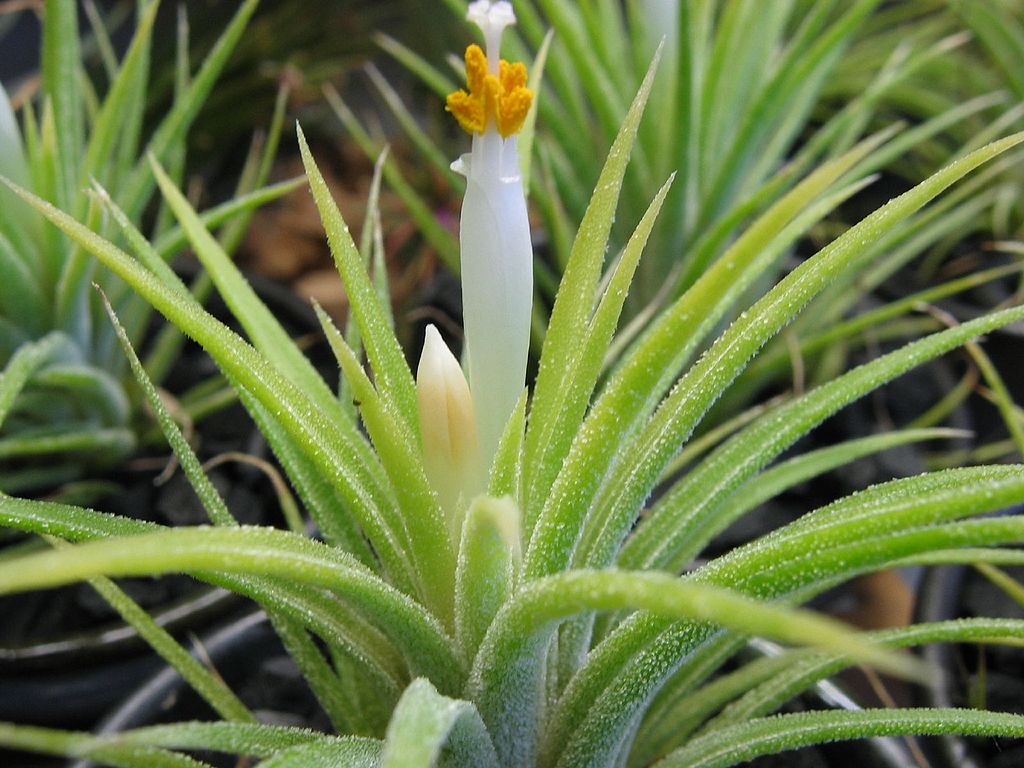
The Tillandsia ionantha ‘druid’ is another popular ionantha cultivar. The ‘druid’ ionantha turns a peachy-yellow color and produces white flowers. Like the other ionanthas, the ‘druid’ is petite and typically between 2 to 4 inches wide. The cultivar is native to Central and Southern America but was discovered by a Florida native who brought a handful of ionanthas back home only to find them blooming yellow rather than the red he expected.
Easy to care for, ‘druids’ prefer humid conditions but can tolerate dry environments provided you mist them regularly. They prefer indirect light as bright light will fade their yellow color.
Tillandsia Kolbii
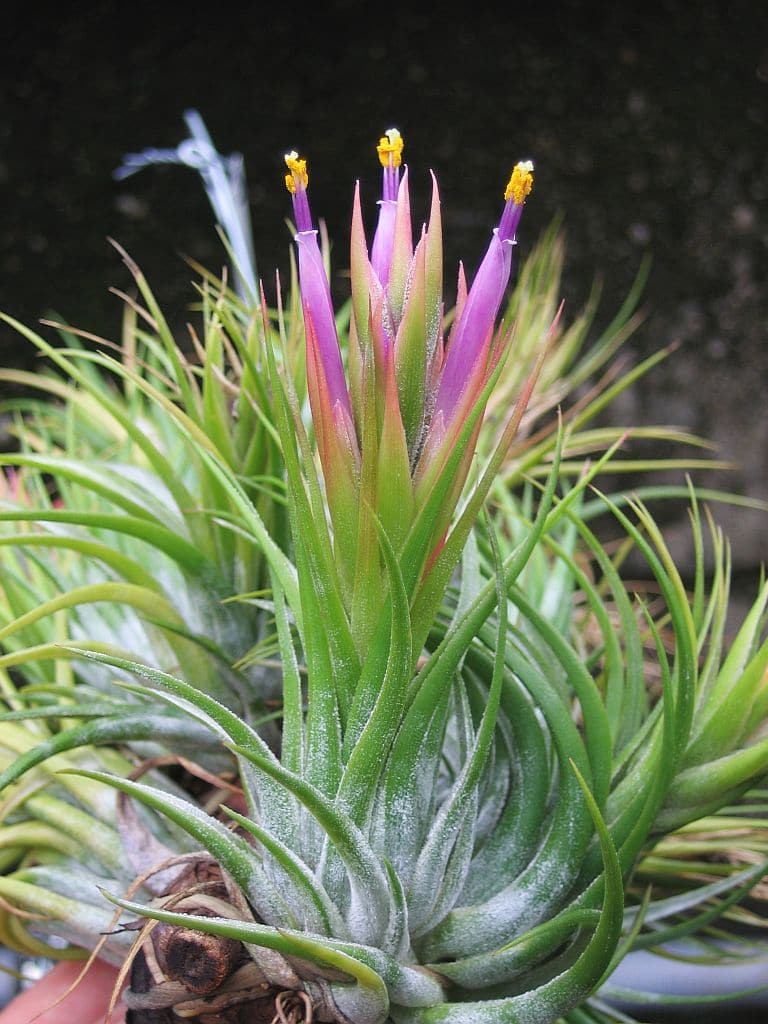
Tillandsia Kolbii always look like they just got caught in a gust of strong wind. They grow tall and in a cluster but always lean slightly off to one side. Some have endearingly likened their appearance to a celery bunch. Their fuzzy green leaves blush pink before blooming and produce a purple flower once in their lifetime.
Tillandsia kolbii are native to Mexico and Guatemala and prefer bright indirect light. They love humidity and will benefit from soaking and misting. They produce plenty of pups that you can either separate or keep together as a clump.
Tillandsia Didisticha
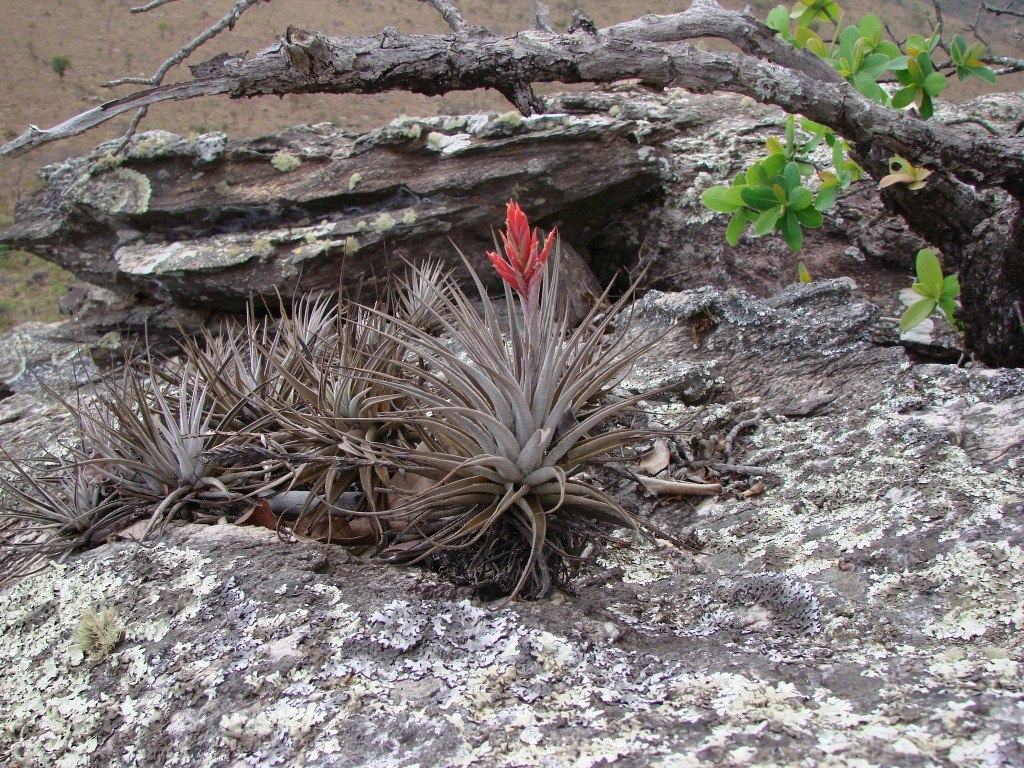
The Tillandsia didisticha is very large for an air plant and can grow to be over 1 foot tall. They are native to mountainous regions across South America, specifically Bolivia, Brazil, Paraguay, and Argentina. They do just fine at altitudes close to 1500 meters above sea level.
The Tillandsia didisticha’s rosette shape comprises long, slender gray leaves. The silver bracts blush pink and produce a white flower. The species was first described in 1888 and has since been bred to produce several popular cultivars.
Tillandsia Usneoides
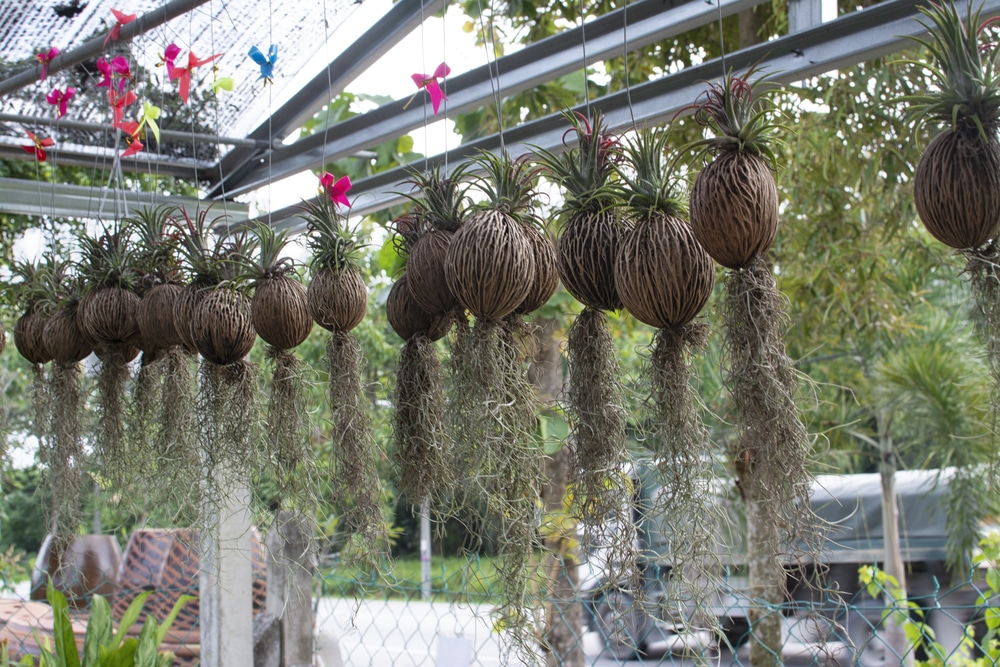
Tillandsia usneoides is almost always referred to by its common name, Spanish moss. Despite the name, Spanish moss is actually native to Northern, Central, and Southern America. In the US, it grows in trees, often in swamplands across the southern states. The history of the name goes back to the Age of Exploration when French and Spanish explorers both named the tree after the long hair of the other party. “French Hair” and “Spanish Beard” were the air plant’s original names, though “Spanish Beard” won out and eventually became Spanish moss.
Spanish moss is an easy and rewarding air plant to grow at home. It resembles a creeping succulent and functions very well as a hanging plant. Spanish moss is unique in that it doesn’t always require water. In very humid conditions, it will be just fine drawing moisture out of the air. But if you live in a dryer climate, you may need to mist it or soak it occasionally. Fasten it somewhere with bright light and water as needed.
Tillandsia Cacticola
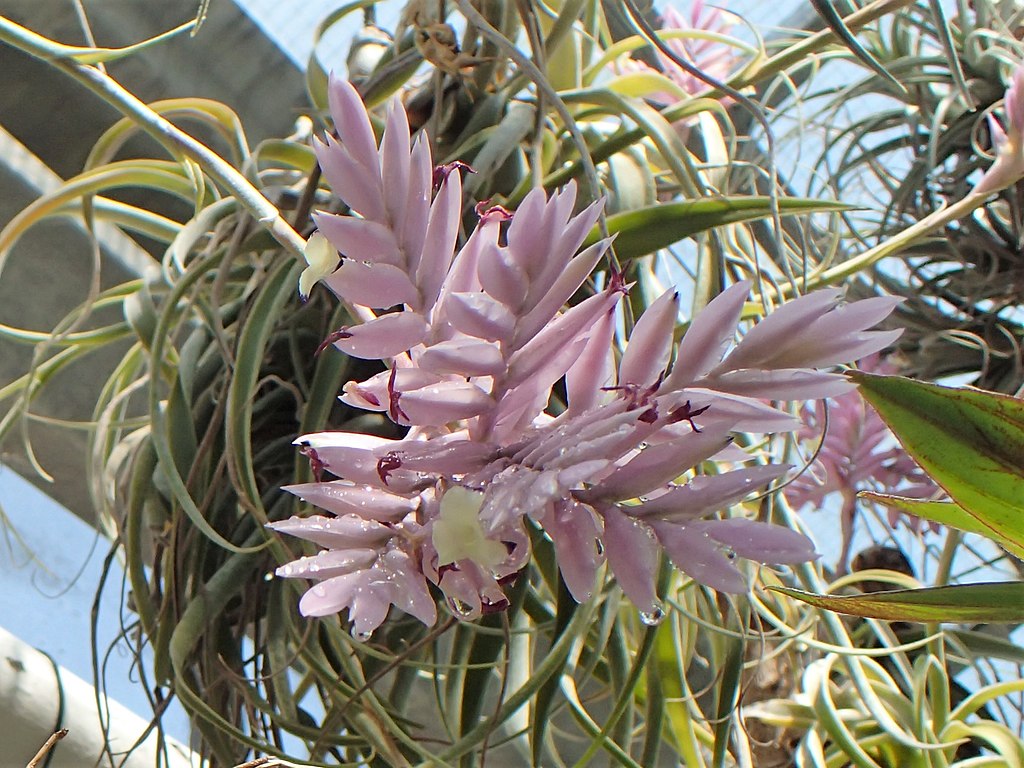
The Tillandsia cacticola is a beautiful but less common air plant than others on this list. It doesn’t produce many offsets and grows rather slowly. Still, it’s highly valued because of its unique flower. The silvery-green rosette of leaves is nice enough, but when it comes time to bloom, the air plant will put out a long shoot with a lavender flower. The flower opens up to reveal an array of small blossoms.
Tillandsia cacticola can be found clinging to rocks or cacti, hence the name cacticola. They are native to Peru and can survive elevations of 2000 meters above sea level. Tillandsia cacticola likes bright, indirect light and can tolerate dry conditions.
Tillandsia Punctulata
Tillandsia punctulata is a medium-sized air plant with curved leaves that create a rosette shape. It is commonly referred to as a Mexican black torch because the base of its green and deep purple leaves can appear almost black. It produces upright spikes of funnel-shaped flowers. The showy flowers tend to have several sepals and petals and can be a vibrant red. Tillandsia punctulata can grow to be 1.5 feet tall, making them the largest variety on this list. They enjoy bright, light, and a healthy amount of moisture, even though they are drought tolerant.
Tillandsia Tectorum
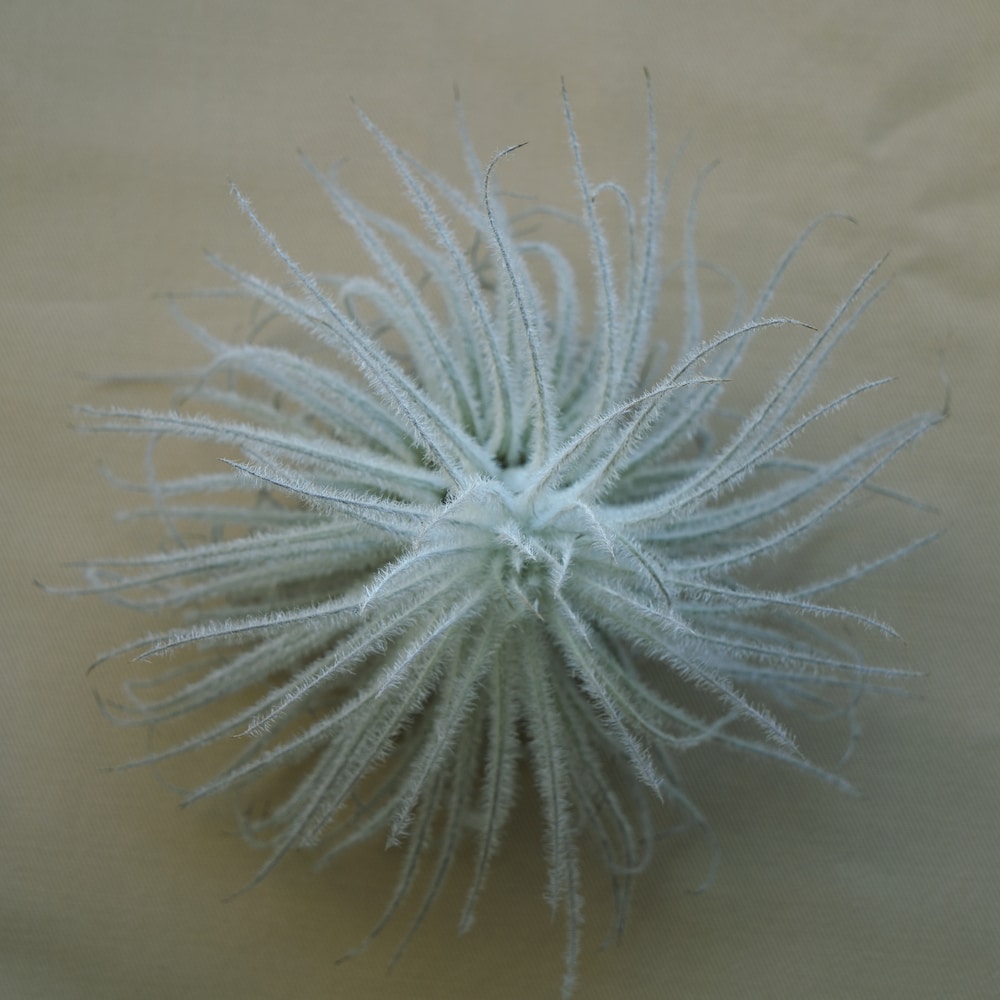
It’s not hard to see why the Tillandsia tectorum is commonly referred to as the snowball. The white spherical air plant has more wispy trichomes than most air plants which adds to the white snowball look. They’re fuzzy, lightweight, and soft to the touch. Due to their abundance of trichomes, the snowball is very drought resistant. This means you should take extra care when watering. We suggest dunking rather than soaking, and taking extra care to ensure that all parts of the plant are thoroughly dry before returning it to its home.
The Tillandsia tectorum is quite rare and therefore a bit pricier than some of the other varieties on this list.


Through research over the years I am finally doing very well with tillandsias, however I still have absolutely no luck with bulbosa and occasional bad luck with ionantha. They always rot and die even though I follow directions online. They both have one thing in common. They require high humidity. But the recommended amount of moisture kills them?
Where can I buy air plants ?
Hi Dorothy, I usually recommend buying plants on Etsy! I’ve had great experiences there.
There are many on Etsy. The three I would recommend are Black River, Plant Oddities & Twisted Acres. All provide high quality air plants at reasonable prices & top notch service!
How do I encourage them to produce pups ?